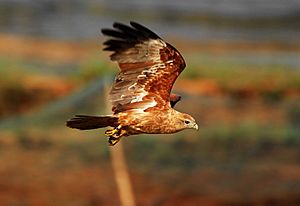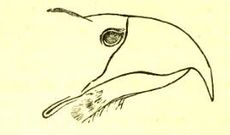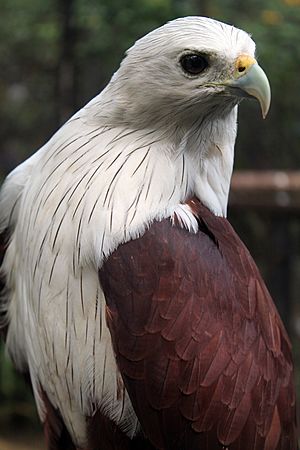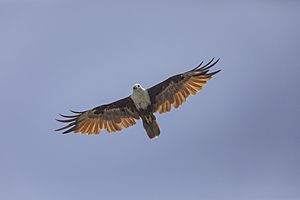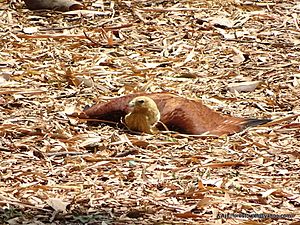Brahminy kite facts for kids
Quick facts for kids Brahminy kite |
|
|---|---|
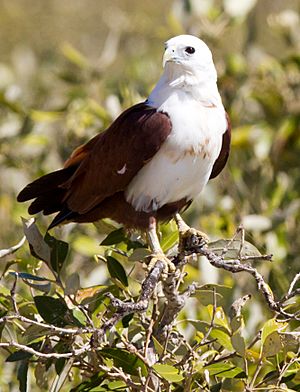 |
|
| In Pilbara, Western Australia | |
| Conservation status | |
| Scientific classification | |
| Genus: |
Haliastur
|
| Species: |
indus
|
The brahminy kite (Haliastur indus) is a medium-sized bird of prey. It belongs to the family Accipitridae. This family includes many other birds like eagles and buzzards. These kites are found in the Indian subcontinent, Southeast Asia, and Australia. They usually live near coasts and wetlands. Here, they mostly eat dead fish and other small animals. Adult brahminy kites are easy to spot. They have a reddish-brown body with a bright white head and chest.
Contents
What is a Brahminy Kite?
The brahminy kite was once called the red-backed sea-eagle in Australia. It's a type of raptor. Raptors are birds that hunt and eat other animals. This bird is known for its striking colors. Its white head and chest stand out against its reddish-brown body. The tips of its wings are black. Young kites are browner. But you can still tell them apart from other kites. They have shorter wings and a rounded tail.
Where Does the Brahminy Kite Live?
This bird is common in the skies of many countries. You can see them in Sri Lanka, Nepal, India, Pakistan, and Bangladesh. They also live across southeast Asia and down to New South Wales, Australia. They are widespread and live in these areas all year. Sometimes, they move around depending on the rainfall.
They are mostly seen in flat plains. But they can also be found high up in the Himalayas. This bird is listed as "Least Concern" on the IUCN Red List. This means it is not currently threatened. However, their numbers are decreasing in some places, like Java.
How Do Brahminy Kites Look?
The brahminy kite has very clear and contrasting colors. Its body is chestnut-colored. Its head and chest are white. Its wing tips are black. Young kites are browner. But they look different from black kites. They appear paler and have shorter wings. Their tail is rounded.
The brahminy kite is about the same size as the black kite. It flies like a typical kite, with its wings angled. Its tail is rounded. This is different from the red kite and black kite, which have forked tails. The sound they make is a soft, mewing keeyew.
What Do Brahminy Kites Do?
Brahminy kites build their nests from December to April in South Asia. In Australia, it's from August to October in the south and east. In the north and west, it's April to June. They build nests in trees, often in mangroves. They use small branches and sticks. The inside is lined with leaves. They often return to the same nesting spot each year. Sometimes, they even nest on the ground under trees.
A mother kite lays two eggs. The eggs are dull-white or bluish-white. Both parents help build the nest and feed the young. But usually, only the female sits on the eggs. The eggs hatch in about 26 to 27 days.
What Do Brahminy Kites Eat?
These birds are mostly scavengers. This means they eat dead animals. They especially like dead fish and crabs. You can often see them near wetlands and marshlands. Sometimes, they hunt live prey. This can include small animals like hares or bats. They might also try to steal food from other birds. This is called kleptoparasitism. They have even been seen taking advantage of Irrawaddy dolphins. The dolphins herd fish to the surface, making them easy to catch. Once, a kite was even seen eating honey from a beehive!
Other Interesting Behaviors
Young brahminy kites sometimes play. They drop leaves and try to catch them in the air. When they are fishing, they might land in the water. But they can swim and fly off easily.
They often gather in large groups to sleep. They roost together on big, isolated trees. As many as 600 kites have been seen sleeping in one place!
They sometimes mob larger birds of prey. This means they fly around and harass them. For example, they might mob steppe eagles. In some cases, the eagles have fought back and injured or even killed the kites.
Brahminy Kites in Culture
 The brahminy kite is important in many cultures. In Indonesia, it's called elang bondol. It is the official mascot of Jakarta, the capital city. In Hinduism, this bird is seen as a modern version of Garuda. Garuda is a sacred bird and the vehicle of the god Vishnu.
The brahminy kite is important in many cultures. In Indonesia, it's called elang bondol. It is the official mascot of Jakarta, the capital city. In Hinduism, this bird is seen as a modern version of Garuda. Garuda is a sacred bird and the vehicle of the god Vishnu.
The island of Langkawi in Malaysia is named after this bird. Kawi refers to an ochre-like stone. This stone was used to decorate pottery. It also refers to the bird's main feather color.
A story from Bougainville Island tells about a mother who left her baby under a banana tree. The baby floated into the sky while crying. It then turned into Kaa'nang, the brahminy kite. The baby's necklace became the bird's feathers.
For the Ibans in Borneo, the brahminy kite is very special. They believe it is the god Singalang Burung coming to earth. Singalang Burung is a powerful deity. He is known as the god of war.
Images for kids
-
Brahminy kite eating, Kabini Reservoir, India
See also
In Spanish: Milano brahmán para niños



